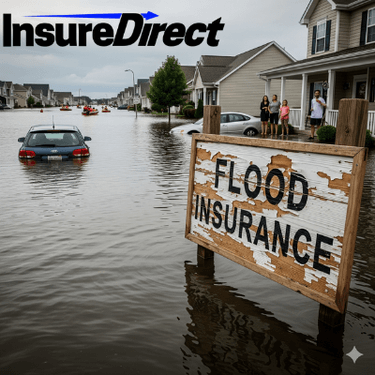I been thinking about this lately, you know, the whole flood insurance thing. Most people don’t actually realize—your regular home insurance won’t save you if water comes rushing in the living room. Crazy right? I found that out by mistake a few years back.
Flood insurance, it’s not some fancy extra. It’s more like a seatbelt. You don’t think about it, until you wish you had it buckled. The gov (FEMA, they run something called NFIP) and also some private companies sell these policies. The boring part: they cover the house itself and your stuff inside, but not like your backyard shed falling over in a storm.
High-risk areas? You basically gotta have it.
Lemme put it plain: If your place sits in a FEMA flood zone (the scary ones with the big red outlines on maps), the bank don’t even give you a choice. They demand flood insurance before you sign off on the loan. Mortgage lenders hate risk more than cats hate bathtubs.
Houses near rivers, lakes, or anywhere water sneaks in
I once stayed at my cousin’s house near a small creek, thought it’s harmless. Rained two nights straight and boom, water creeping across his driveway. He didn’t expect it, no one ever does. So yeah, even if you’re not in the “official” high risk category, still worth thinking about.
Renters get stuck too
Lot of people renting don’t know—your landlord’s policy covers his building, not your couch or your laptop. If water floods the unit, all your personal stuff could be toast. Renters can actually buy contents-only flood insurance, which is cheaper, but very few people do.
Business owners: not immune either
Floods don’t check if you got a family or a storefront. If you own a small shop, restaurant, or office in a storm-prone place—imagine losing equipment, computers, shelves of stock. One storm could wipe it all. Business flood insurance helps, but yeah, cost varies like crazy.
Don’t trust the “low-risk” label
Funny thing? About a quarter of flood claims come from outside the “danger zones.” FEMA maps are helpful but they ain’t perfect, and weather keeps changing. I’d say anyone in a so-called moderate risk area should look at policies cause premiums are way lower there, like bargain compared to high-risk.
Coastal homes are magnets for water
People living along the Atlantic, Gulf, or even Pacific, they already know the drill. Hurricanes push water onto land, tides keep climbing higher. Even if the house sits on stilts or got seawalls, water finds a way. I’ve seen pictures where whole blocks went underwater while some owners thought they were “safe enough.”
Why bother if it’s not mandatory?
Folks usually skip flood insurance unless the bank makes them. Huge mistake, honestly. First, climate patterns keep shifting—we get floods in places where it never happened before. Second, damage costs are brutal. FEMA says one inch of water? That’s twenty-five thousand dollars in damage. Not exaggerating. Third, federal disaster relief isn’t free money. At best you get a loan, which still gotta be paid back.
The money part—what it costs
Average NFIP policy runs something like $700 to $1000 yearly. Not peanuts, sure. But compared to the price of replacing your walls, floors, furniture, it’s small. In “low-risk” areas, the cost drops a lot. Some private companies also offer better deals or more flexible coverages, so shopping around pays.
So, do you need it?
Let me throw this at you: can you personally afford to rebuild your home, replace everything, all on your own cash, if a flood hit tomorrow? If not, then yeah—you need flood insurance. Doesn’t matter if you’re a renter, homeowner, shop owner, or just someone with a little house by the creek.
Floods don’t care where you live. And, honestly, the peace of mind is worth it. I’d rather pay that premium every year than risk losing everything.
If you’re seeking reliable insurance coverage, InsureDirect is your go-to solution. Requesting a home insurance quote is quick and straightforward. Contact us or visit our website today:
InsureDirect.com
Corporate Home Office
618 South Broad Street
Lansdale, Pennsylvania 19446
📧 contact@insuredirect.com
📞 (800) 807-0762 ext. 602
Protect your home and enjoy peace of mind with InsureDirect—because your home deserves the best.

